Table of Contents
- Introduction to Digital Health
- Editor’s Choice
- Digital Health Statistics – Adoption and Usage of mHealth Apps
- Digital Health Statistics – Wearable Healthcare Technology and Adoption
- Telemedicine Market Growth and Adoption Trends
- Digital Health Statistics – RPM: Adoption and Usage
- Digital Health Statistics – Technology for Mental Well-being
- Adoption and Usage of IoMT Technologies
- Patient Acceptance and Comfort with Smart Pills
- Digital Health Statistics – Advancing Digital Health with AI
- Digital Health Statistics, by Country
- Recent Developments
- Wrap Up
- FAQs
Introduction to Digital Health
Digital Health Statistics: Digital health is a rapidly growing field encompassing digital technologies, such as mobile apps, wearables, telemedicine, and electronic health records, to improve healthcare delivery, enhance patient outcomes, and empower individuals to take control of their health.
Digital health statistics provide valuable insights into the adoption, usage, and impact of these technologies in various aspects of healthcare.
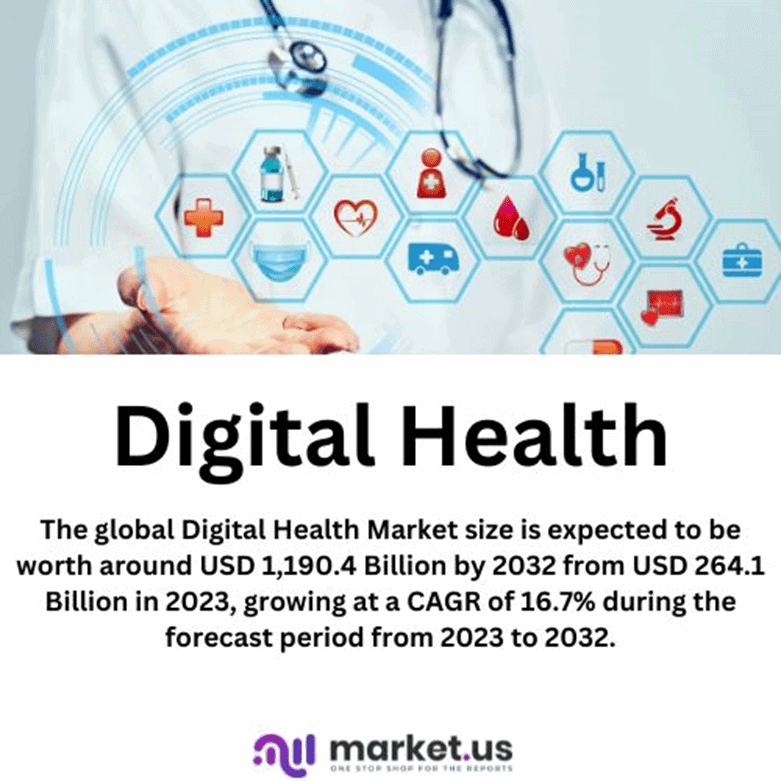
Editor’s Choice
- The global Digital Health Market size is expected to be worth around USD 1,190.4 Billion by 2032 from USD 264.1 Billion in 2023, growing at a CAGR of 16.7% during the forecast period from 2023 to 2032.
- The US showed a 154% increase in telehealth usage in the first quarter of the year 2020.
- 76% of people over the age of 55 have used telemedicine.
- In the 2022 Survey, 80% of all respondents reported having accessed care via telemedicine at some point in their lives, up 8pp from 72% in 2021.
- 23.4 million U.S. patients will utilize remote patient monitoring services and tools in 2022.
- By 2024, remote patient monitoring services and tools are expected to reach 30 million U.S. patients.
- 80% of Americans favor remote patient monitoring and more than one-half strongly support incorporating it into medical care services.
- Approximately 30% (1266 out of 4551) of the adult population utilize wearable healthcare devices.
- The most likely groups to report using wearable healthcare devices were women 16.25%.
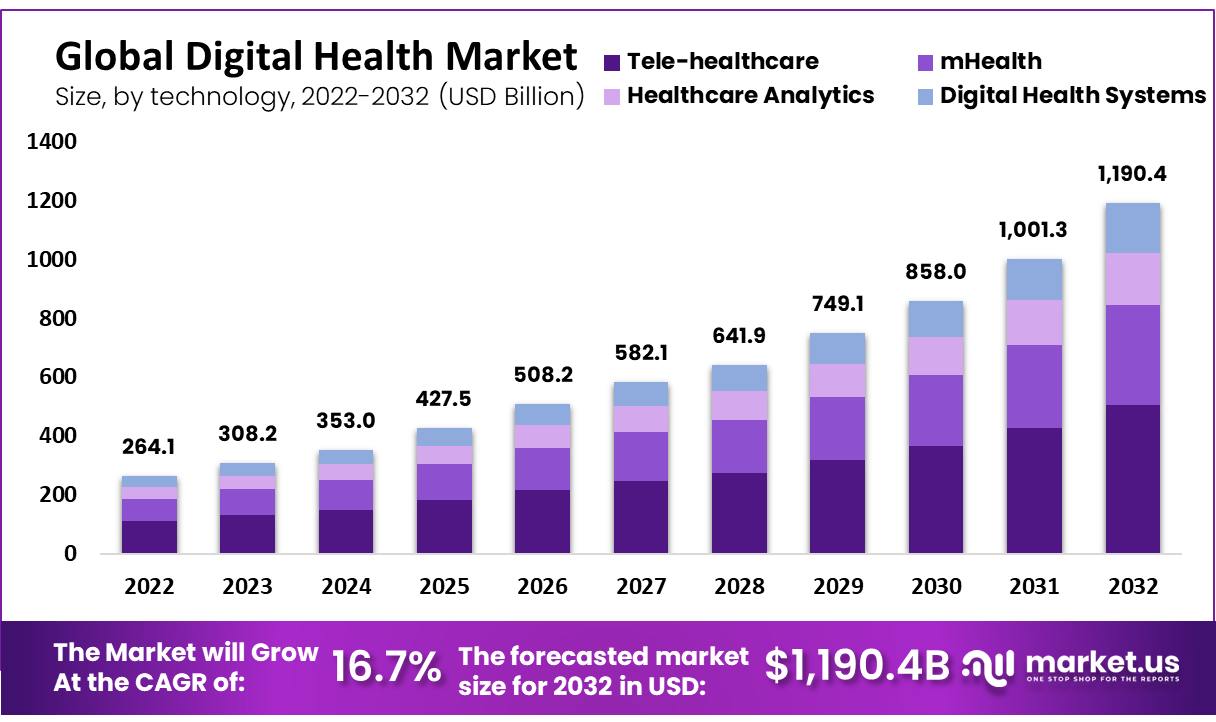
(Source: Market.us, Willis Towers Watson-2022, Rock Health, NCBI)
Digital Health Statistics – Adoption and Usage of mHealth Apps
mHealth apps are applications that are designed for mobile devices, such as smartphones and tablets, that help in providing healthcare-related services and information.
These apps are aimed to provide individuals with health and wellness information. Below are some common features of mHealth apps.
- The global mHealth market accounted for revenue of USD 50.8 billion in 2022.
- The market is expected to grow at a revenue of USD 150.7 Bn in 2032.
- The market is growing at a CAGR (2022-2032) of 11.8%.
- The market is expected to reach a revenue of USD 56.8 billion at the end of the year 2023.
- Up to February 2022, more than 3,50,000 apps were available on different lay store platforms and they are, mostly used by older adults aged from 50-80 years.
- 3 in 10 adults reported that they are using at least one health app on their smartphone.
- 16% of adults said that they used health apps at least once in the past.
- 56% of adults reported that they haven’t used mHealth apps.
- During the last period, there were 54,546 healthcare and medical apps available on the Google Play Store, a small decrease as compared to the previous quarter.
More Insights
- Between the beginning of 2020 and the end of 2021, the number of health apps available to Android users via Google Play Store reached more than 65,300 thousand during the last quarter of 2021.
- 34% of older adults are dependent on this technology to achieve their health goals and exercise activities.
- 22% of users downloaded health apps to get insights about nutrition.
- Due to the rising prevalence of obesity, 20% of users downloaded health apps to track their weight loss activities.
- 17% of users are dependent on health apps to track their sleep.
- 9% of users download health apps for meditation.
- 5% of people use health apps for the management of chronic mental illness or stress.
(Source: market.us, vicert, Statista, vice)
Reasons for Using mHealth App – Digital Health Statistics
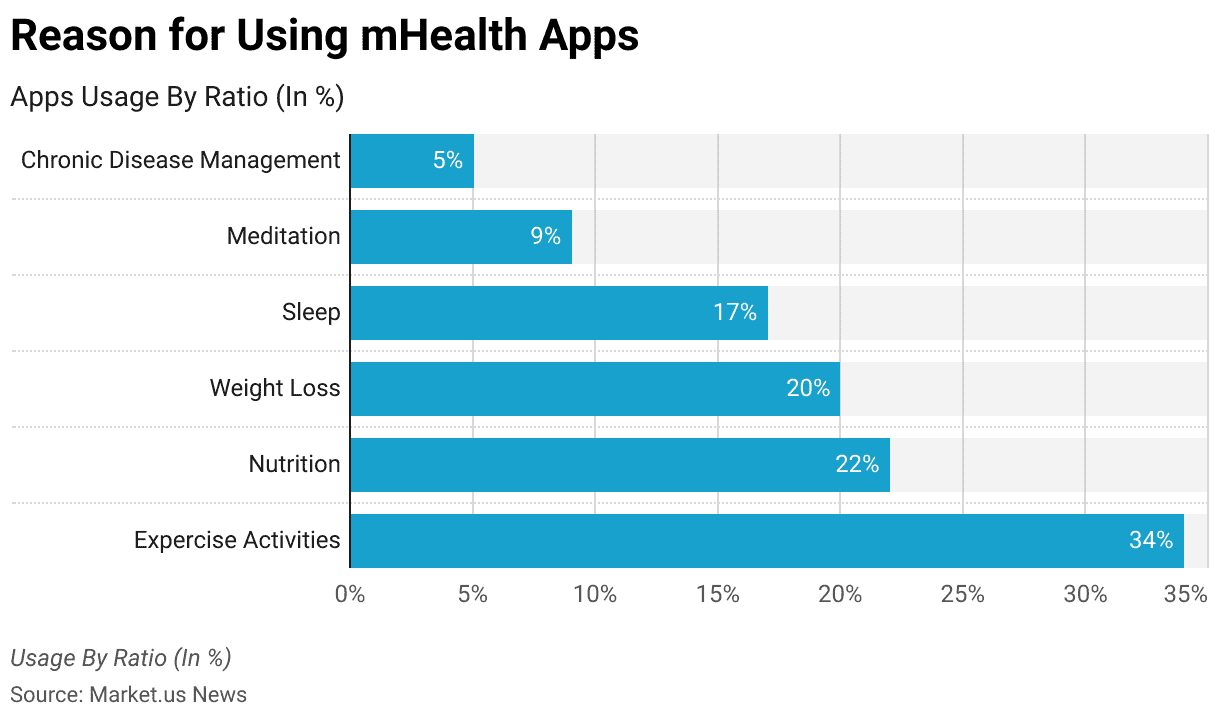
Digital Health Statistics – Wearable Healthcare Technology and Adoption
Wearable healthcare technology generally refers to devices worn by the user, that can track various health metrics and provide data and insights about the user’s health and well-being.
Take advantage of our unbeatable offer - buy now!

This includes fitness trackers, smartwatches, medical-grade wearables, and other devices that can monitor vital signs, activity levels, sleep quality, and other health-related data.
- 30% of Americans living in households with an annual income of at least $75,000 wear either a fitness tracker or a smartwatch. In contrast, only 12% of individuals earning less than $30,000 per year use such devices.
- The most likely groups to report using wearable healthcare devices were women 16.25%.
- Nearly 50% of users are dependent on wearable technology in daily life, with more than 80% of users willing to share their data with their healthcare providers.
- Number of connected wearable devices worldwide is rising from 325 million in 2016 to 722 million in 2019.
- Shipments of smartwatches were 100 million in 2020.
- Earwear or ear-worn device shipments were increased by 45% to 105 million units by 2023.
- According to the National Library of Medicine, the accuracy and precision of wearable devices typically range from 92% to 99%.
- Wearable technology will flourish over the next 25 years, resulting in global cost savings of over $200 billion in the healthcare industry.
(Source: vicert, NCBI, VICERT, Statista, NIH)
Smartwatch Usage for Health Monitoring and Fitness Insights
- 59% of people use smartwatches to track their number of steps per day.
- 42% of people use smartwatches to get insights regarding their workout/athletic performance.
- 37% of people use smartwatches to monitor their heart health.
- 35% of people use smartwatches to check their sleep quality and duration of sleep.
- 32% of people get insights regarding calories burned with the help of smartwatches.
- 17% of people use smartwatches to check their stress levels.
(Source: Deloitte)
Digital Health Statistics – Smartwatch Usage
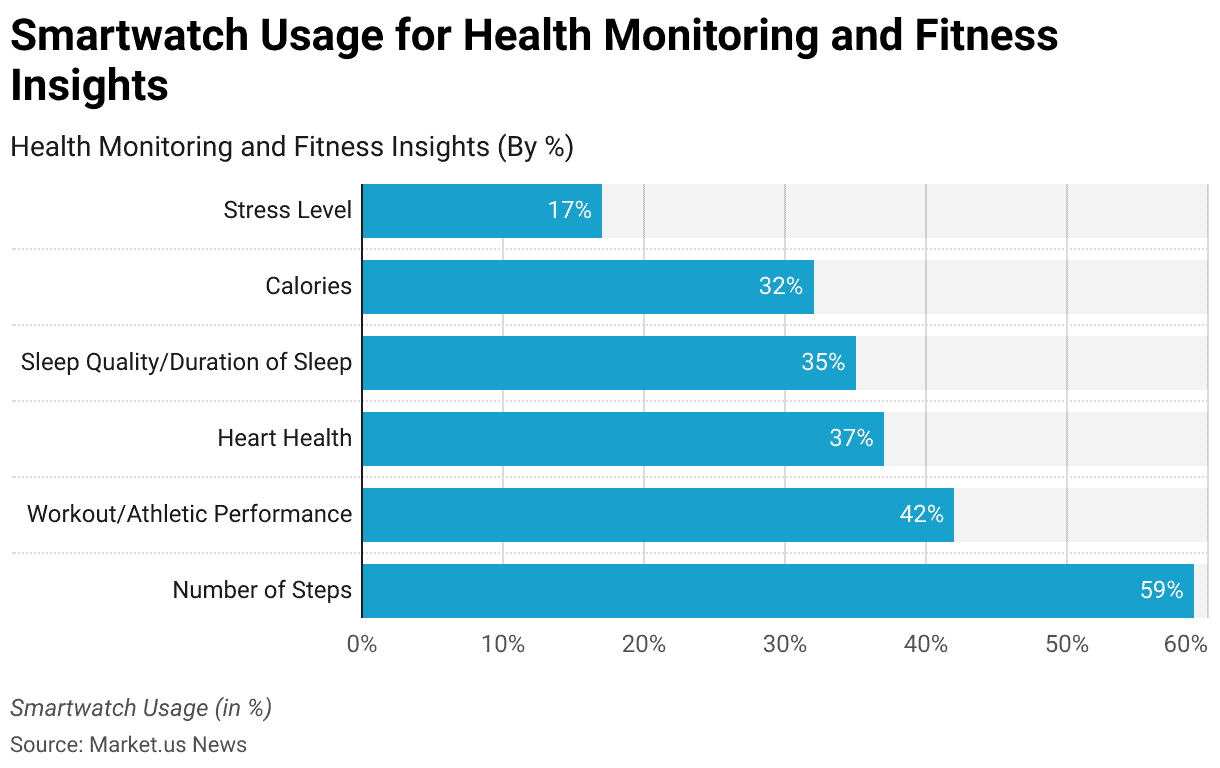
Telemedicine Market Growth and Adoption Trends
Telemedicine is a healthcare service that uses telecommunication technology to provide clinical care to patients remotely.
This telemedicine service uses video conferencing, mobile apps, messaging platforms, and other communication technologies that allow doctors and other healthcare professionals to provide medical diagnoses.
- The global telemedicine market size is expected to be worth around USD 590.9 Bn by 2032 from USD 63.5 Bn in 2022, growing at a CAGR of 25.7% during the forecast period from 2022 to 2032.
- Telemedicine use also increased among women, with 82% of women respondents reporting having used telemedicine.
- 82% of Hispanic respondents reported telemedicine use.
- 61% of respondents reported preferring telemedicine and minor illness care 51% of respondents reported preferring telemedicine.
- Asia Pacific region showed a 52% increase in telehealth access to primary physicians/general patient services from 4% to 56%.
(Source: Market.us, Willis Towers Watson, 2022)
Digital Health Statistics – RPM: Adoption and Usage
Remote patient monitoring (RPM) refers to the use of technology to collect health data from individuals outside traditional healthcare settings and transmit this data back to healthcare providers for analysis and monitoring.
- By 2024, remote patient monitoring services and tools are expected to reach 30 million U.S. patients.
- 80% of Americans favor remote patient monitoring and more than one-half are strongly supportive of incorporating it into medical care services.
- 88% of patients surveyed reported having access to remote healthcare in the past year.
- 9 out of 10 healthcare providers polled had indicated they already invested in remote patient monitoring technologies.
- Physicians’ perceptions that digital health tools benefit patient care increased from 85% in 2016 to 93% by 2022 – and this increase can be observed regardless of physician age or specialty.
- 70% of medical professionals rated telemedicine in the COVID-19 pandemic.
- Asia Pacific region showed a 52% increase in telehealth access to primary physicians/general patient services from 4% to 56%.
- According to research conducted, over 23 million patients were already using remote patient monitoring tools and services by 2020; with this number expected to surpass 30 million people by 2024.
- Virtual visits conducted by physicians rose from 14% in 2016 to 80% by 2022, and remote monitoring devices more than doubled from 12% in 2016 to 30% by 2022.
- University of Pittsburgh Medical Center achieved patient satisfaction scores exceeding 90% by equipping its patients with remote patient monitoring equipment and tablets.
(Source: nonagon)
Digital Health Statistics – Technology for Mental Well-being
- According to a survey on mental wellness conducted in India in May 2022, about 61% of female and 55% of male respondents stated that they had used digital technologies such as apps and smart devices to manage their mental well-being.
- There are more than 10,000 mental health apps available in major app stores.
- About 86% of therapy clients believed that teletherapy sessions are more effective than in-person therapy.
- Artificial Intelligence and machine learning technologies are beneficial in developing predictive models for mental health conditions. AI algorithm could predict the onset of psychosis with 93% accuracy.
- Approximately 44% of individuals with mental health conditions do not receive treatment due to barriers such as stigma, cost, and limited access to providers.
- Around 70% of individuals reported that they would feel comfortable seeking mental health support from a Chatbot.
- It is projected that the user penetration will be 0.13% in 2023 and it is expected to hit 0.15% by 2027.
More Insights
- About 46% of adults aged 18-34 years have used mental health apps at least once.
- According to Deloitte, there are more than 20,000 mental health apps available on major online platforms.
- Calm and Headspace are the two most popular mental health apps worldwide. The total revenue of the Calm.com mobile app in April 2023 was USD 7 million, including USD 6 million for iOS apps and USD 1 million for Android apps. The total number of Calm app downloaders was 800k in April 2023.
- Around 83% of therapists in the United States recommended mental health apps to their clients.
- Mental health apps are popular among college students. About 60% of students report using mental health apps to manage their well-being.
- Global consumer spending on mental health apps reached USD 270 million in 2020, which is up by 32.5% compared to the previous year. While in 2022, mental well-being apps generated USD 491 million in consumer spending, up by 82.5% compared to 2020.
(Source: Statista, PsyberGuide, American Psychological Association, National Institute of Mental Health, Nature, Calm.com)
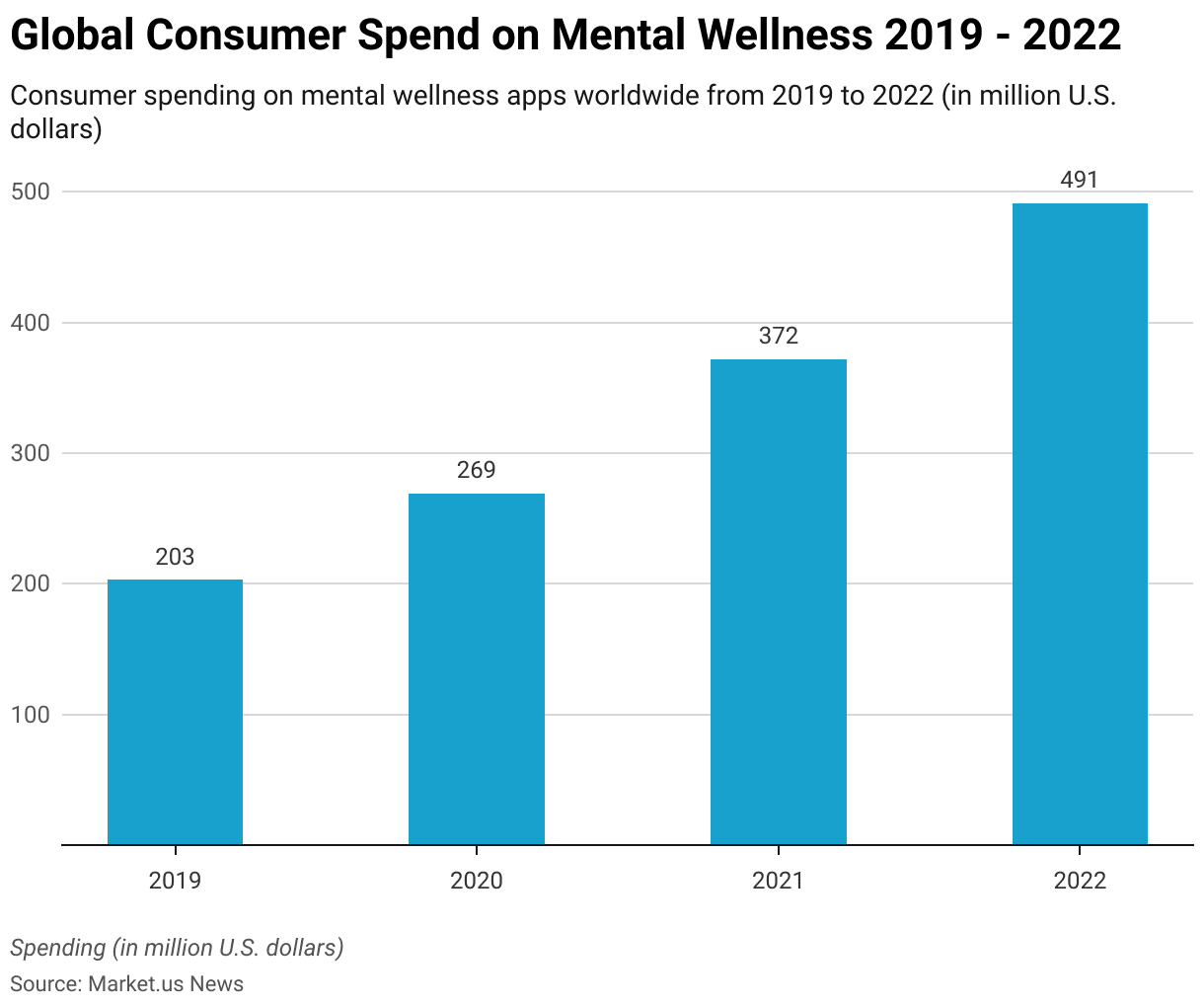
Adoption and Usage of IoMT Technologies
- Patients are adopting IoMT technologies, with about 64% of patients using at least one IoMT device in their daily lives.
- Connected medical devices accounted for the largest market share within IoMT, with a market share of USD 63.7 billion by 2026.
- IoMT-enabled remote patient monitoring can reduce hospital readmission by 50%.
- IoMT solutions have the potential to save the healthcare industry USD 300 billion annually in remote patient monitoring of chronic management.
- In 2022, the global Internet of Medical Things market was valued at US$ 48.7 billion and is expected to grow to US$ 370.9 billion. Between 2023 and 2032, this market is estimated to register a CAGR of 23.15%.
- North America is estimated to be the dominator in the global Internet of Things market, with the largest market share of 35.8% and revenue of USD 17.43 billion.
- 30% of American adults use wearable technology for healthcare as of 2020.
- According to Deloitte Insights, the global market of wearable devices for the medical sector is booming. Compared to 275 million units in 2021, it is projected to reach nearly 440 million units in 2024.
- 59% of healthcare providers reported that they have already implemented IoMT solutions in their organizations.
- About 83% of organizations adopted IoMT solutions.
- About 85% of healthcare providers use IoMT devices to support patient engagement and monitoring.
(Source: Deloitte, Frost & Sullivan, Healthcare IT News, market.us)
Patient Acceptance and Comfort with Smart Pills
- The global smart pill market is projected to reach $4.75 billion by the end of 2023, growing at a CAGR of 16.6% from 2018 to 2023.
- Approximately 500,000 capsule endoscopies will be conducted annually worldwide by 2022.
- Around 50% of patients do not take their medications as prescribed, a challenge that smart pills could address.
- A study published in the Journal of Medical Internet Research found that smart pills improved medication adherence by up to 15%.
- About 78% of patients said they would feel comfortable ingesting a smart pill if prescribed, suggesting high patient acceptance.
- By 2022, approximately 500,000 capsule endoscopies were conducted annually worldwide, reflecting the growing use of diagnostic smart pills.
- A study by the University of California showed that an AI algorithm could predict inflammatory bowel disease development in 86% of cases using data from smart pills.
- A survey published in Drug Delivery Letters in 2022 indicated that around 78% of patients surveyed would feel comfortable ingesting a smart pill if prescribed by their healthcare provider.
- A separate study focused on the elderly, a demographic particularly prone to chronic diseases, found that 73% of participants were open to using smart pills for health monitoring and medication management.
(Source: journals, benthamscience, journals)
Digital Health Statistics – Advancing Digital Health with AI
Artificial Intelligence in healthcare refers to the use of advanced computer algorithms and machine learning techniques to analyze data in the healthcare sector to provide better healthcare services.
AI helps healthcare providers to make more accurate and real-time diagnoses, personalize treatment plans, and improve patient safety by identifying health risks earlier.
- According to market.us, the global artificial intelligence in the healthcare market was valued at USD 9.81 billion in 2022. It is projected to reach USD 238.5 billion at a CAGR of 38.73% between 2023 to 2032.
- About 45% of healthcare services worldwide adopted data integration software for their organizations.
- 36% of organizations implemented natural language processing software.
- North America is dominant in global AI in the healthcare market with the largest market share of 59.1%.
- By 2030, annual healthcare spending in the United States is expected to reach $6.8 trillion.
- The government share of this spending is projected to be 48% by 2030, driven by increases in Medicare enrolment, as more than 10,000 Americans become eligible for Medicare each day.
- 1.8% of organizations in the United States use machine learning in healthcare services.
- According to a Deloitte survey of 1,100 US managers whose organizations were already pursuing AI, 63% of companies surveyed were employing machine learning in their business.
- According to market.us, the global artificial intelligence in drug discovery market was valued at USD 1.2 Billion in 2022. Between 2023 and 2032, this market is estimated to register the highest CAGR of 27.5%. It is expected to reach USD 12.8 Billion by 2032.
(Source: Statista, market.us, whitehouse, NIH)
Digital Health Statistics, by Country
United States
The United States has been a leader in digital health, with a thriving ecosystem of digital health start-ups, investments in healthcare technology, and widespread adoption of telemedicine and health information exchange. It is home to major companies and research institutions driving innovations in digital health.
- In 2022, there were a total of 572 digital health start-up deals funded in the United States.
- In 2021, the total value of venture funding towards the digital health sector in the United States amounted to approximately 29 billion U.S. dollars.
- According to a survey carried out among U.S. physicians, about 65% of respondents had not used telehealth before the COVID-19 pandemic. During the peak of the COVID-19 pandemic, 43% of physicians were seeing over 50% of their patients via remote health monitoring technology.
- Telemedicine use increased with age and was higher among women (42.0%) compared with men (31.7%).
- The percentage of adults who used telemedicine increased with education level and varied by family income.
(Source: Statista, cdc.gov)
China
China has significant growth in digital health, driven by its large population, increasing adoption of smartphones, and government support for healthcare technology. The country has witnessed the rise of telemedicine platforms, health apps, and AI-powered healthcare solutions.
- As of December 2022, more than 363 million individuals in China have used online medical services (About 34% of the total population).
- About 84% of clinicians in China believe that in the coming 10 years’ patients will have easy access to remote monitoring tools to assess their healthcare and well-being.
- The IoMT market in China is projected to reach a revenue of USD 7.68 billion in 2023.
- The revenue is projected to show a CAGR of 13.17% (2023-2028).
- Revenue in the Medical Devices segment in China is projected to reach US$31.24bn in 2023.
- About 84% of clinicians in China believe that in the coming 10 years’ patients will have easy access to remote monitoring tools to assess their healthcare and well-being.
(Source: Statista)
United Kingdom
The UK has been proactive in adopting digital health solutions, including electronic health records, telehealth, and mobile health applications. The National Health Service (NHS) has played a key role in promoting and implementing digital health initiatives.
- Revenue in the Digital Health market is projected to reach US$4.07bn in 2023.
- Revenue is expected to show an annual growth rate (CAGR 2023-2027) of 9.02%, resulting in a projected market volume of US$5.75bn by 2027.
- In 2021, 35% of respondents in the United Kingdom stated that they had used virtual consultations with a medical provider in the last year.
- In 2020, 87% of clinicians surveyed in the United Kingdom reported using electronic health records.
- According to the NHS Digital Apps Library, there were more than 480 apps listed in 2021, covering various health-related topics such as mental health and chronic disease management.
- In 2020, UK digital health start-ups raised over USD 500 million in funding.
- In 2020 alone, there were 1.2 million telehealth appointments in the United Kingdom.
- According to NHS, there were about 88% of patients used telehealth services in 2020.
(Source: Statista, ons)
Israel
Israel has emerged as a global leader in digital health, often referred to as the “Start-up Nation.” Healthcare start-ups in Israel are focusing on areas such as telemedicine, health monitoring, medical devices, and artificial intelligence (AI) applications for diagnostics and treatment.
- The digital health market in Israel is expected to reach USD 729.6 million in 2023.
- There are about 537 digital health companies active in Israel, out of them 204 companies were AI/machine learning companies.
- Revenue in the eHealth segment is projected to reach US$492.00m in 2023.
(Source: Statista)
Recent Developments
Acquisitions and Mergers:
- HealthTech Solutions acquired HealthTech Innovations for $500 million, consolidating its position in the digital health market and expanding its portfolio of healthcare technology solutions.
- DigitalCare Inc. merged with WellnessTech, forming a strategic partnership to offer integrated digital health platforms and comprehensive wellness solutions, with combined annual revenues projected to surpass $1 billion.
New Product Launches:
- HealthTrack introduced a mobile app for remote patient monitoring, enabling patients to track their health data and communicate with healthcare providers, aiming for 1 million downloads within the first year.
- TeleMedica launched a virtual care platform for telemedicine consultations and digital health services, targeting 500,000 users within six months.
Funding Rounds:
- DigitalHealth received $100 million in Series B funding led by Healthcare Investment Group XYZ to scale up their digital health platform and invest in artificial intelligence algorithms for healthcare analytics, aiming for a 50% increase in user engagement within the next year.
- HealthTech secured $50 million in seed funding from Tech Investors ABC to develop innovative digital health solutions and expand their market reach, targeting a 40% growth in revenue over the next fiscal year.
Consumer Trends:
- Rising demand for digital health solutions fueled the adoption of telemedicine and remote patient monitoring, with telehealth visits increasing by 30% compared to the previous year.
- Mobile health apps surged in popularity during the COVID-19 pandemic, with a 50% increase in downloads of health and wellness apps, reflecting growing interest in self-care and digital health management.
Regulatory Landscape:
- Regulatory agencies implemented guidelines for telemedicine reimbursement and data privacy, ensuring adherence to quality standards and patient confidentiality in digital healthcare delivery.
Investment in Research and Development:
- Healthcare organizations and technology companies allocated significant resources to research and development in digital health technology, with an estimated $5 billion invested globally in digital health advancements and market expansion initiatives.
Wrap Up
Digital Health Statistics – Digital health has emerged as a transformative field that leverages technology to enhance healthcare delivery, improve patient outcomes, and increase accessibility to medical services.
Countries around the world have recognized the potential of digital health and have been actively investing in its development.
Ongoing advancements in digital health hold significant potential for improving healthcare outcomes, reducing costs, and empowering individuals to take charge of their health.
With further innovation and collaboration, digital health has the potential to transform healthcare systems globally and bring about positive changes in patient care.
FAQs
Digital health refers to the use of digital technologies, such as electronic health records, telemedicine, mobile health apps, wearables, and artificial intelligence, to improve healthcare delivery, patient care, and health outcomes.
Digital health offers several advantages, including improved access to healthcare services, remote patient monitoring, enhanced communication between patients and healthcare providers, personalized medicine, better disease management, streamlined administrative processes, and potential cost savings.
Remote patient monitoring offers several benefits, including early detection of health issues, timely interventions, improved patient engagement and empowerment, reduced healthcare costs, enhanced efficiency of healthcare delivery, and improved overall health outcomes.
Discuss your needs with our analyst
Please share your requirements with more details so our analyst can check if they can solve your problem(s)



